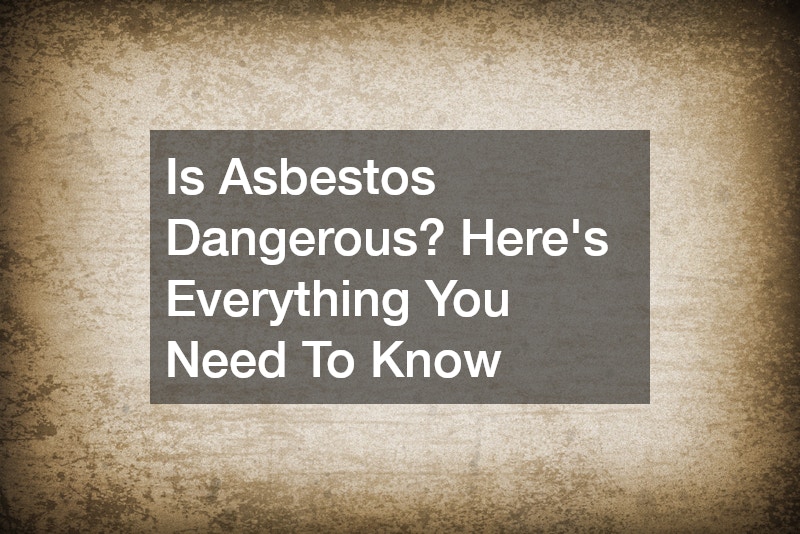Asbestos, once hailed as a “miracle mineral” for its fire-resistant properties, has since been recognized as a significant health hazard. Despite its widespread use in construction and manufacturing for much of the 20th century, the dangers of asbestos exposure have led to stringent regulations and widespread efforts to remove it from buildings. But why exactly is asbestos so dangerous, and what should you know about it? This article aims to provide a comprehensive overview of asbestos, its risks, and the importance of conducting an asbestos survey.
What is Asbestos?
Asbestos is a group of naturally occurring fibrous minerals known for their heat resistance, strength, and insulating properties. These characteristics made asbestos an ideal material for a variety of applications, including insulation, roofing, flooring, and fireproofing.
However, the same fibrous nature that made asbestos useful also makes it dangerous when inhaled.
Health Risks of Asbestos
The primary danger of asbestos lies in its tiny fibers. When materials containing asbestos are disturbed, these fibers can become airborne and easily inhaled. Once inhaled, they can lodge in the lungs and other tissues, leading to serious health conditions over time. The most severe illnesses associated with asbestos exposure include:
Lung Cancer: Inhaled asbestos fibers can cause lung cancer, a condition that may take decades to develop after initial exposure.
Mesothelioma: This is a rare and aggressive cancer that affects the lining of the lungs, chest, or abdomen. It is almost exclusively caused by asbestos exposure.
Asbestosis: This chronic lung disease involves the scarring of lung tissue, leading to symptoms such as shortness of breath, persistent cough, and chest pain.
Pleural Disease: Asbestos exposure can cause the pleura (the lining around the lungs) to thicken and build up fluid, leading to breathing difficulties and other respiratory issues.
Why Was Asbestos Used?
Despite its dangers, asbestos was widely used because of its durability and fire-resistant properties. It was seen as a versatile and cost-effective solution for many construction and manufacturing needs. Its resistance to heat, electricity, and chemical corrosion made it a go-to material for everything from building insulation to automotive brakes. However, the health risks associated with asbestos were not fully understood until the latter half of the 20th century, leading to its decline in use and eventual ban in many countries.
Asbestos Regulations and Bans
As the dangers of asbestos became more apparent, governments worldwide began to regulate its use. In the United States, the Environmental Protection Agency (EPA) and the Occupational Safety and Health Administration (OSHA) have established regulations to limit asbestos exposure in the workplace and protect public health. Many other countries have enacted similar laws, and some have banned asbestos use entirely. Despite these efforts, asbestos remains a hazard in older buildings and materials, making it essential to identify and manage any asbestos-containing materials (ACMs) properly.
The Importance of an Asbestos Survey
Conducting an asbestos survey is crucial for anyone involved in renovating or demolishing older buildings. An asbestos survey involves a thorough inspection of a property to identify the presence and condition of any asbestos-containing materials. This process helps ensure that asbestos is safely managed and removed, preventing exposure and protecting health.
There are two main types of asbestos surveys:
Management Survey: This type of survey is typically conducted in buildings that are in use and not undergoing any major renovations. Its purpose is to ensure that any asbestos present remains in good condition and is not disturbed.
Refurbishment and Demolition Survey: This more comprehensive survey is conducted before any major renovation or demolition work. It involves inspecting all areas of the building where work will be carried out to ensure no asbestos is accidentally disturbed during the process.
What to Do If You Find Asbestos
If an asbestos survey reveals the presence of asbestos in your property, it is crucial to handle it correctly. Here are the steps to take:
Do Not Disturb: Avoid touching or disturbing any asbestos-containing materials, as this can release harmful fibers into the air.
Hire a Professional: Contact a licensed asbestos abatement professional to assess the situation and safely remove or manage the asbestos. Do not attempt to remove asbestos yourself.
Follow Regulations: Ensure that all asbestos removal and disposal are carried out according to local regulations and guidelines to protect your health and the environment.
Conclusion
Asbestos poses significant health risks, but with proper awareness and management, these dangers can be mitigated. Conducting an asbestos survey is an essential step in identifying and managing asbestos in buildings, ensuring the safety of occupants and workers. If you suspect the presence of asbestos in your property, do not hesitate to seek professional help. By taking the right precautions, you can protect yourself and others from the serious health effects of asbestos exposure.
.


